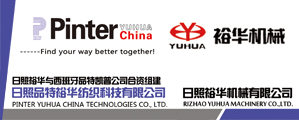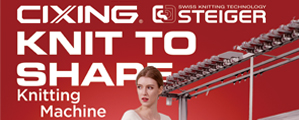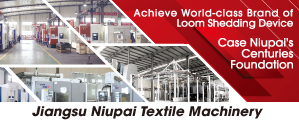Textile machinery industry: seizing the technological advancement opportunity to achieve a qualitati
Jan 29, 2016 | by
Textile machinery industry: seizing the technological advancement opportunity to achieve a qualitative leap
Interview with Wang Shutian, president of China Textile Machinery Association
By Xu Yuanyuan

China Textile: year 2015 is the last year of the 12th Five Year Program as both the economic environment and industrial environment have been faced with special difficulties. How isitgoingwiththe overall operation of the textile machinery industry and what is the characteristic and trend presented?
Wang Shutian: The overall textile machinery market is not very good, but there are no losses inthe profitstaken together in thetextile machineryindustry.The spinning and chemical fiber machinery manufacturers have more outstanding difficultieswhile the tech-textile machinerycompaniesmove ahead in business performance at stable rate. The growth of export,boosted by international industry relocations, increased fast since last yeartoexceed 3 billion dollars, which is a reflection of the international recognition of the quality level of machinery in our country. In April 2015, the export surpassed the import for the first time in the history of the development of China’s textile machinery.
The outstanding performance of export was driven by the price of cotton so that many enterprises transferred their capacity abroad which brought new installations and reconstructive projects in foreigncountries.Additionally, our robustexport growth was also driven by the development and improvement of the industry abroad in recent years,calling for the continuous upgrading and updating of the equipment. The export destinations are mainly concentrated in India, Vietnam, Pakistan, Indonesia and Bangladesh wherethe textileindustryhasbeen economic bases, ensuring quick startand growth.
In addition, the cost factorsin raw materialand power etc.are alsothe drivers forthe obvioustrend ofoutgoing investmentinnew operations.In order to survive, the companies strengthened their efforts on going global.
The domestic marketfor textilemachinery is not that good, as isaffected by the plain situation of the spinning sector itself and particularly,as always, bythe raw material market,leading tothe difficulty inmanaging production cost and to theinadequacyinability and power to have a technical renovation. As a consequence,the sale of spinning frame,a traditional majorproductin textile machinery enterprises,is on thedramatical decline.The same is true of the weavers whowere also affected bythe rising price in cotton and yarn.As the cotton and yarn are more expensive at home, the weaving enterprises choose to importto maintain business, but theexisting difficultyindeed hassome impact on the market of weaving machines. Because of the excess production capacity, chemical fiber industry was affected by restricting output. The market for chemical fiber machinesneeds more differentiated products and models in the specialty products field even thoughthe market share is not big.
Next, we are looking forward to the downstream market that can solve the problem of the associated costs. A few years ago, the downstream enterprises’ labor cost is sooutstandingthat it brought the drive and influences of the automation and robot for the textile machineryin the textile millswithsignificant change. In addition, in the aspect of energy conservation and emission reduction, textile machinery has lots of breakthroughs for enterprises innovation. In terms of green weaving, the textile machinery also made great adjustment centering on industrial structure.
China Textile: “Made in China 2025” plan was formally put forward in 2015, what kind of effect does this plan will make on textile machinery industry and how to respond to? Specific to the enterprises, how to catch up with the development pace aimed at 2025?
Wang Shutian: the textile machinery industry is in advance of the textile industry to enter into the period of structural adjustment, for the manufacturing mode is the most important adjustment stepthat starts from machines.“Made in China 2025” initiative compiled our industry into it. Academician Yao Mu led the work teamin the textile chapterandwe are a big part of it. Therefore, in the process of drafting, “made in China 2025” initiative was closely related to the textile machinery industry.
Referring to German Industry 4.0, we know that it is a must for our textile machinery industryto carry out industrial structure adjustmenttowards this direction in the future. Toreach the goal,the enterprises will beon thetransformationmoveateitherfast or slow step, providedthatthe researchconditions andpersonnelmeettherequirements of this trend.In general, the enterprises know that they must do that.
In terms of the structure of the product, there has been thorough transformation in textile machinery industry. The textile machinery on sale now is completely different from the traditional ones a few years ago, including smart, digital control, energy-saving and cost-reducing types; moreover, the product quality and reliability have beenmuch improved withobvious changes.
The good news is that the nowadays enterprises united with some research institutions and users closely in terms of the product research mode, unlike what’s to bedone allby themselves before. The modernityfor the textile machinery productionis characteristicof combining with the market and consumers from the design ina very outstandingprogress made jointly byproducers,universities,research institutionsandclients.
China Textile: In your opinion, what characteristics does the textile machinery industryhave in terms of scientific and technological development? Under the condition of the new technology progressing, how does the textile machinery industry achieve the combination between production and technology effectively?
Wang Shutian: in terms of technological advance, the textile machinery industry has got many Science and Technology Progress AwardsinLight of TextileProgram, granted by CNTAC as well as national awards. So the technological advance has a strong staying power. Some new fields are making progress at the same time, for example, how to unite communication technology and Internet technology into production research and manufacturing, and product marketing. It is the “Internet Plus” that should beemphasized and used in textile machinery industry.
The digital printer enterprises produced andbuilt some websites at the same time. There are requirements for the consumers to decorate the bridal chamber, so they can surf the internet to find the bedding, sofa, and curtain, etc. they can choose the patterns and designs all by themselves. The enterprises will produce the products by digital and printing technologies uponthe orderingwithout being subjected to volume production. The website can be extended to any home textile fabric stores, consumers choose the designed products at any time and it is very convenient for them to pick up goods directly in stores. The combination of technology and productionbonds the product research, manufacturing and sales together.
China Textile: as the intelligenceandrobot-substitute-for-human drive has become the “ongoing tense”, what is the situation of the textile machinery intelligent process?
Wang Shutian: Nowadays, the machinery manufacturing enterprises are considering how to face the future. First of all, they should know what the future will be and clearly understand what we lack now. Secondly, how to build the digital factory that belonged to them. These consciousnesses are obvious in textile machinery enterprises.
It is inevitablefor robot to substitute human being, a trend that the traditional weaving ways cannot achieve at presentforthe automation does not needso many workers. Taking night duty as an example, theautomatic spinning frame and roving frame keep no operatorson night duty, which depends onthe mechanic reliabilityto guaranteethe continuous yarns. Once there’s broken yarn, theintelligentdesignmakes surethe regular production of other links should be guaranteed. This is the inevitable development from production requirements.
Such a shit is a must for enterprises to produce whatthe textilemills need. If we cannotmanufacture and supply these kinds of intelligentequipment, our clients will go global to buy. This is nothing but the market demand and push, and an inevitable trend of development.
There is no doubting that there still exists a large gap in intelligence-modemachines, comparingthe international level. However, this is also a great chance for us to access to the international level at the same time. The intelligent innovation enables us to have a clear understanding of ourselves. It’s a matter for joy that it shall be a test for quality of all basic parts in order to realize intelligenceinmachine line. In terms of intelligent and modernized science and technology, we are standing on the same starting line with the international enterprises.Whileweadmitthere is a gap in theindustrial foundations in the pastindustrializationhistory, we can make up the gap by Internet and advanced technologies,a chance for catching up and closing to the international level.
China Textile: in your opinion, our country’s textile machinery manufacturing is at what level? With the strengthening of the industrial foundation, what are the new development direction and trend of the textile machinery manufacturing in China?
Wang Shutian: along with the development of the textile machinery, the production becomes more highly efficient, as theintelligent designwillconnectwhereitstands aloneor apartinto aseamlessintegrity inthe process flowin the futurewith no need foroperatorsinbetween. For example, automatic transportation and hanging system is the inevitable result of the production cost and labor factors.
Therefore,the textile machinery enterprises should be guided to developfaster. We should grasp every bit of information about demand, making the Chinese textile machinery industry go better on their own land. At present, the machinery industry should think over on the structural contradictions between the unemployed population and the want of employmentto meet the growing and various needs and changes of the workers.
The country revitalizes the equipment manufacturing industry, and textile machinery industry is one of it. Our “size” is not big, but the development state is very good and healthy, resulting in the continuous improvement of the textile machinery industry’s comprehensive strength. There are no monopoly resources in textile machinery industry in our country; they developed their businessesall by themselves with high degree of privatization. In 2014, the textile machinery industry has accounted for 78% of the domestic market share and the percentage would exceed 80% by the end of year 2015. Although the textile enterprises relied mostlyon import in the past,the status is no longer what it usedto be,with agame-changescenario now.
China Textile: what do you think of the textile machinery industry will present new development trend and characteristics from the last quarter of year 2015 to the beginning of the 13th Five Year Program?
Wang Shutian: the most important link is to accelerate structural adjustment during the 13th Five Year Program period regarding the whole textile machinery industry. The industrial technology and technique should be researched and promoted, which is closely related to the textile industry. We should firmly step up industrial structure adjustment and keep ourselves updatedof the market demand for technical equipment in all industries, restructuring our owncompaniesand responding to the market demand quickly to establish a better system.
It isvery imperative thatthe entire industry should better improve the innovation ability starting from products development. And how?The efforts should be paid on industrial innovation alliance and the first pilot projects have been started. The other corresponding alliances should be made up from the industrial chain.
In addition, the sound development of the textile machinery industry should be guaranteed in some waythat theagreementshould be reached with the enterprisestoprotecttechnical intellectual property rights(IPR) in regardtohow to protectIPR. Everyone should consciously maintain the intellectual property rights for protecting othersfor thesimple reason that we are protecting ourselves at the same time. As a result,some serious cases, likecut-throat competitions with low pricethat had happened repeatedly, were no longer in existence in the past two years.
China Textile: what advantages does the domestic textile machinery have compared with the European textile machinery products? And what gap still exists?
Wang Shutian: the most obvious difference is the understanding of the market economy. As the economy in our country has experienced a shift from a planned economy to a socialist market economy, we are lack of experience and some enterprises do not fully understand the rules of the market economy. Therefore, the biggest gap lies in the idea. We should also know how to set up a research and development team and possess what kind of R&D base for establishing a centennial enterprise. The idea is a must for making good equipment,but ittakessome time before takes forms.
At present, we have pioneered some technologies which lead the international level. The facts have proved that we are not always following the others and the development of the textile machinery industry will get better and better under the improvement of the environment and production conditions.
China Textile: what do you think of the textile market and the development trend of the domestic textile machinery?
Wang Shutian: the direct change will be brought for our life by hardworking and innovation of the Chinese textile machinery industry. There is no country in the world that can replace the status of the China’s textile industry. With the transformation of industrial upgrading, the demand for textile machinery will be very high.









